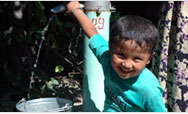Frequently Asked Questions About USAID's Family Planning Services
Since 1965, the United States Agency for International Development (USAID) has supported international health assistance programs that provide voluntary family planning services. This support has saved the lives and health of women and children, helped stabilize world population, protected the environment, and promoted U.S. political and economic interests in the developing world. USAID is the world's largest bilateral donor contributing to these programs.
Access a complete text of the brochure Family Planning Programs - Saving Lives, Protecting
the Environment, Advancing U.S. Interests [PDF, 1.9MB], including
related graphs and charts.
- Why is family planning critical to successful development programs?
- How does family planning help women, their families, and their communities?
- Can family planning play a crucial role in the fight to prevent the spread of HIV/AIDS?
- Do family planning programs help protect the environment?
- How does USAID provide family planning assistance to the developing world?
- Has USAID's family planning assistance been successful?
- How much do taxpayers spend on USAID's international family planning assistance?
- Do Americans support international health assistance?
- How fast is world population growing?
- Is the U.S. imposing family planning programs on poor nations and on poor women?
- What do you mean by family planning and reproductive health programs?
1. Why is family planning critical to successful development programs?
Family planning assistance saves lives, improves health, contributes to healthier children, and prevents abortion.
Those countries in the developing world that have invested in health and education and have provided women access to family planning and reproductive health programs have experienced faster economic growth than those that have not. When couples can choose the number, timing and spacing of their children, they are better able to adequately feed and educate their children, potentially ending the cycle of poverty. Communities thrive, and in turn, countries fare better. Today the greatest deficits in access to health services can be found in the poorest segments of the population. By channeling resources to family planning, nations can save lives, stabilize population growth, slow the spread of AIDS, reduce poverty and improve women’s position in society.
2. How does family planning help women, their families, and their communities?
Family planning can expand life choices for women and girls. Postponing early marriage and childbirth among girls and young brides through family planning increases their chances of receiving a good education. Education is vital not only to women's individual development, but to that of their children as well as to the social, political, and economic growth of their community. Men and women who participate in USAID-supported family planning programs want to. They desire the information they need to make appropriate decisions about their family size and the spacing of their children.
3. Can family planning play a crucial role in the fight to prevent the spread of HIV/AIDS?
Family planning programs, with years of experience addressing individuals' and couples' sexual and reproductive health needs, are well-placed to help prevent HIV/AIDS, help those who are HIV negative stay negative, or keep one partner from infecting the other. Adding family planning to voluntary counseling and testing (VCT) and prevention of mother-to-child transmission (PMTCT) sites are cost effective health interventions that allow health care workers to reach ever more people with lifesaving services. Since HIV is currently incurable, prevention is vital. Half of all new HIV infections in the developing world are among women and nearly 10 percent of infections are among infants and children, who become infected through mother-to-child transmission.
4. Do family planning programs help protect the environment?
A healthy environment is vital to ensuring the health of our families, and vice versa. Rapid population growth can result in using up the environment's resources - the trees, the water, and the wildlife - more quickly than they are replaced. For example, encroachments on the environment have led to new infectious diseases while water shortages are seriously affecting people in the developing world. The World Wildlife Fund's Living Planet Report (2000) has estimated that the Earth's ecosystems and renewable natural resources have declined 33 percent over the past 30 years while demands on these ecosystems have increased by more than 50 percent. The facts speak for themselves:
- More than one-third of the world's people live in areas suffering from chronic water shortages.
- Each year, some 40 million acres (nearly the size of Washington State) of tropical forest disappear as trees are cleared for crops, human settlements, and fuel wood.
- Three-fourths of the world's agricultural lands are degraded and cities are filling with people leaving rural areas because of expanding population and failing land.
5. How does USAID provide family planning assistance to the developing world?
USAID's family planning programs range from health to social to technical interventions and assistance. USAID supports programs in more than 60 countries in Africa, Asia, Latin America, the Caribbean, Eastern Europe, and the former Soviet Union at the host government's request. The Agency's strategy for family planning is to provide high quality, voluntary health care services that are easily available to many people. Essential elements of our programs include counseling and services, training of health workers, contraceptive supplies and their distribution, financial management, public education and marketing, and biomedical and contraceptive research and development. USAID support is based on a broad reproductive health approach which emphasizes choice among a wide range of contraceptives, improved quality of care, and client-centered services. USAID family planning programs are increasingly integrated with other community-based efforts to improve maternal and child health, enhance women's status, and prevent HIV transmission and other infectious diseases.
6. Has USAID's family planning assistance been successful?
USAID's family planning program is one of the most successful components of U.S. foreign assistance. Since the Agency began providing family planning services in 1965, the use of modern family planning in the developing world has more than quadrupled, going from less than 10 percent to more than 40 percent. In the 28 countries with the largest USAID-sponsored family planning programs, the average number of children per family has declined by 1/3rd, from more than 6 to less than 4. For example, densely populated Bangladesh, the number of children per family has fallen by nearly in half in just four decades. In the 1960s, fewer than 10 percent of women in Bangladesh used a modern family planning method and families averaged over six children. Today, 42 percent of women use a modern method, and couples are having, on average, three children per family.
Secretary of State Colin Powell has said it best: "(family planning) is a wise investment, it is a good use of the people's dollars to invest in activities outside our borders which affect us more and more directly every day because of the nature of the changing world and the impact of globalization. We are not alone. We are not an island anymore. And the investments we make overseas will redound to our credit in due course. This is the work of the American people."
7. How much do taxpayers spend on USAID's international family planning assistance?
This valuable work is done at a low cost. The United States will spend $432 million this year on international family planning programs. This represents only about five percent of USAID-managed foreign assistance.
- This money will provide services to 20 million women, prevent abortions, and save the lives of thousands of women and hundreds of thousands of young children.
- These programs work - programs supported by the U.S. help millions of women in poor countries and are one of the notable success stories in our nation's efforts to reduce poverty around the world.
- Our contribution directly helps people in other countries, but it is a good long-term investment for us in the United States as well.
8. Do Americans support international health assistance?
A study conducted in 2000 by the RAND Corporation showed 8 in 10 Americans favor U.S. aid for voluntary family planning programs in the developing world. In addition, 92 percent agree that couples should have the right to decide the number, spacing, and timing of their children and should have access to the information and means to do so. Their reasons are diverse -improving the health of women and children, enhancing women's status, helping to alleviate world poverty, stabilizing population, protecting the global environment, promoting economic development overseas, or pursuing the economic self interest of the United States. Another survey by the Gallup Organization, taken in 2002, also shows that 73 percent of Americans believe the health of the world should be a concern to the U.S. because health is a global issue; 67 percent believe the US should be involved in global health policy to protect Americans' health; and 64 percent believe we must be involved to protect America's vital interests.
9. How fast
is world population growing?
New 2004 figures from the Population Division of the United
Nations Secretariat show the number of people in the world is expected
to rise by 2.6 billion, from today's 6.5 billion to 9.1 billion in 2050. Almost all growth will take place in developing regions, where
population is expected to rise from today's 5.3 billion to 7.8 billion,
according to World Population Prospects. By contrast, developed countries' population will remain mostly unchanged, at 1.2 billion.
These projections are contingent on couples having access to family
planning and that efforts to arrest the current spread of HIV/AIDS
epidemic are successful in reducing its growth momentum.
Some of the ways spiraling population growth can be addressed is by
promoting access to reproductive health (including family planning), fighting HIV/AIDS to save millions of lives from AIDS and maternal death,
and reducing poverty in developing countries.
10. Is the U.S. imposing family planning programs on poor nations and on poor women?
No. Men and women who participate in USAID-supported family planning programs do so on a voluntary basis, free of coercion, and with the information they need to make appropriate choices regarding their use of contraception.
Couples want smaller families. Recent surveys show that desired family size is smaller than actual size in almost every country in the developing world, regardless of religion and culture. More than 120 million women in developing countries would like to postpone or stop having children but are not using modern contraception, and the number of reproductive-age couples is expected to increase by at least 15 million each year.
The vast majority of the world's nations recognize that family planning programs play an important role in human and economic development. About 130 national governments subsidize family planning services, including about 65 developing countries that specifically seek to slow population growth. USAID assists countries only at their request. No USAID family planning funds go to China.
11. What do you mean by family planning and reproductive health programs?
Reproductive health encompasses any issue that relates to the health or disease of the reproductive system. Reproductive health needs vary over the course of an individual’s life. The activities additional to family planning encompassed by reproductive health include: linking family planning with maternity services, HIV/AIDS and STD information and services, eliminating female genital cutting, and supporting post-abortion care. It also includes reproductive health problems that are less a focus for USAID assistance, such as reproductive cancers.
|


